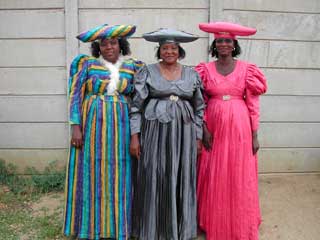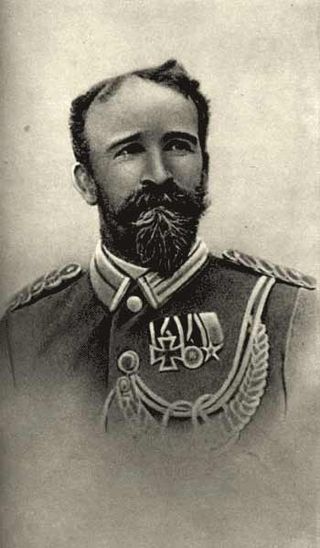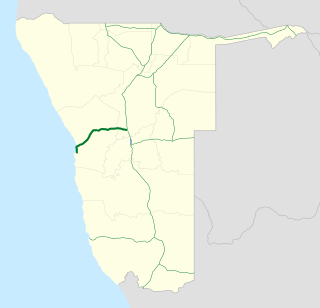
Swakopmund is a city on the coast of western Namibia, 352 km (219 mi) west of the Namibian capital Windhoek via the B2 main road. It is the capital of the Erongo administrative district. As of 2011, the town had 44,725 inhabitants and 196 km2 (76 sq mi) of land. In 2023, the population had increased to 75,921 people.

Karibib is a town in the Erongo Region of western Namibia. It has 3,800 inhabitants and owns 97 square kilometres (37 sq mi) of town land. Karibib is the district capital of the Karibib electoral constituency. It is situated on the Khan River, halfway between Windhoek and Swakopmund on the B2, the main road between Walvis Bay and Johannesburg. The town is known for its aragonite marble quarries and the Navachab Gold Mine.

The Herero are a Bantu ethnic group inhabiting parts of Southern Africa. There were an estimated 250,000 Herero people in Namibia in 2013. They speak Otjiherero, a Bantu language. Though the Herero primarily reside in Namibia, there are also significant populations in Botswana and Angola, and a small number in South Africa. The Hereros in Botswana and South Africa are there because of displacement during the 1904 - 1908 genocide committed by the German Empire.
Okahandja is a city of 45,159 inhabitants in Otjozondjupa Region, central Namibia, and the district capital of the Okahandja electoral constituency. It is known as the Garden Town of Namibia. It is located 70 km north of Windhoek on the B1 road. It was founded around 1800, by two local groups, the Herero and the Nama.
The Trans-Kalahari Corridor is a paved highway corridor that provides a direct route from the port of Walvis Bay and Windhoek in central Namibia, through Botswana, to Pretoria in Gauteng province in South Africa. It initially cost approximately 850 million Namibian dollars and was officially opened in 1998.

Maharero kaTjamuaha was one of the most powerful paramount chiefs of the Herero people in South-West Africa, today's Namibia.

Carl Hugo Hahn (1818–1895) was a Baltic German missionary and linguist who worked in South Africa and South-West Africa for most of his life. Together with Franz Heinrich Kleinschmidt, he set up the first Rhenish mission station to the Herero people in Gross Barmen. Hahn is known for his scientific work on the Herero language.

Curt Karl Bruno von François was a German geographer, cartographer, Schutztruppe officer and commissioner of the imperial colonial army of the German Empire, particularly in German South West Africa where he was responsible on behalf of Kaiser for the foundation of the city of Windhoek on 18 October 1890 and the harbor of Swakopmund on 4 August 1892.

The Swakop River is a major river in western central Namibia. Its source is in the Khomas Highland. From there it flows westwards through the town of Okahandja, the historic mission station at Gross Barmen, and the settlement of Otjimbingwe. It then crosses the Namib desert and reaches the Atlantic Ocean at Swakopmund. The Swakop is an ephemeral river; its run-off is roughly 40 million cubic metres per annum.

Friedrich Wilhelm Gottlieb Viehe was a German missionary of the Rheinische Missionsgesellschaft and an early settler in present-day Namibia. He was born in Mennighüffen,.

B2 is a major road in Namibia. The highway runs east–west between the major sea port of Walvis Bay and the nation's capital Windhoek.

Okahandja railway station is a railway station serving the town of Okahandja in Namibia. It is part of the TransNamib Railway.
Hermann Heinrich Vedder was a German missionary, linguist, ethnologist and historian. Originally a silk weaver, he received missionary training by the Rhenish Missionary Society in Barmen between 1894 and 1903, whereafter he was sent to German South West Africa in 1905 and worked as a missionary and teacher trainer until his retirement, first for the black workers and prisoners-of-war in Swakopmund, then at the small mission station Gaub in the Otavi Mountains, and from 1922 onwards in Okahandja, where he taught at the Augustineum school.
Gross Barmen is a historic settlement and a recreational spa on the Swakop River in central Namibia, north of Windhoek. It is situated on the District Road 1972, 25 km south-west of Okahandja in the Otjozondjupa Region. Its close proximity to the capital Windhoek makes it a popular weekend destination for locals.

Witvlei is a village in the Okarukambe Constituency in the Omaheke Region of central-eastern Namibia. It is situated on the B6 150 kilometres (93 mi) from Windhoek on the way to Gobabis. It is known for producing high quality meat.

Franz Heinrich Kleinschmidt (1812–1864) was a German missionary and linguist who worked in southern Africa, now in the region of Namibia. He founded the missionary station and town of Rehoboth and together with Carl Hugo Hahn set up the first Rhenish mission station to the Herero people in Gross Barmen. Kleinschmidt is known for his scientific work on the Nama language.
The Augustineum Secondary School, established in 1866, is among the oldest schools in Namibia. Originally situated in Otjimbingwe, it was relocated to Okahandja in 1890, and finally to Windhoek in 1968. Previously also known as the Augustineum Training College and today the Augustineum Secondary School, it is a public school located in Khomasdal, a suburb of Windhoek.
The Swakopmund–Windhoek line was a main 600 mm narrow-gauge railway line in Namibia. It was built in 1897 and operated until 1990 when the route name was changed.
Johannes Rath was a missionary with the Rhenish Missionary Society.














